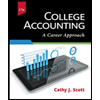
Concept explainers
(a)
Account:
An account refers to a financial record in the general ledger, where the increase or decrease in the values of the assets, liabilities, stockholder’s equity, revenues or expenditures of the business, pertaining to a particular period are recorded. Some of the accounts are assets, liabilities, and stockholder’s equity.
Assets:
Assets are the resources, owned by the company, that are used for the generation of income in the future. Assets are classified under four major heads which are as follows:
- Current assets
- Long-term investments
- Property, Plant and Equipment
- Intangible assets
Some of the examples of assets are equipment, accounts receivable, supplies, and cash.
Liabilities:
Liabilities refer to the financial debts or obligations, which the company is owed to its creditors. The creditors have the claims over the assets of the company. Some of the examples of the liabilities are accounts payable, unearned revenue, and income tax payable.
Stockholder’s equity represents the capital contributed by the shareholders to its business and the revenues generated for the business. Stockholders’ equity is sometimes referred to as the net worth of the shareholders or stockholders. The two parts of stockholders’ equity are common stock and
Normal debit and credit balance:
The excess amount of debit side over the credit side is shown as the normal debit balance. The excess amount of credit side over the debit side is shown as the normal credit balance.
| Type of account | Normal balance |
| Assets account | Debit balance |
| Liabilities account | Credit balance |
| Expense account | Debit balance |
| Revenue account | Credit balance |
| Dividends account | Debit balance |
Table (1)
To indicate: whethereach of the following account is an asset, a liability, or a stockholder’s equity account and whether it would have a normal debit or credit balance.
(b)
To indicate: whethereach of the following account is an asset, a liability, or a stockholder’s equity account and whether it would have a normal debit or credit balance.
(c)
To indicate: whethereach of the following account is an asset, a liability, or a stockholder’s equity account and whether it would have a normal debit or credit balance.
(d)
To indicate: whethereach of the following account is an asset, a liability, or a stockholder’s equity account and whether it would have a normal debit or credit balance.
(e)
To indicate: whethereach of the following account is an asset, a liability, or a stockholder’s equity account and whether it would have a normal debit or credit balance.
Want to see the full answer?
Check out a sample textbook solution
Chapter 3 Solutions
FINANCIAL ACCOUNTING: TOOL
- I need help with this general accounting question using standard accounting techniques.arrow_forwardI am searching for the correct answer to this general accounting problem with proper accounting rules.arrow_forwardThe following direct labor information applies to Summit Tech Co. for the month of April: • Actual labor rate = $12.50 per hour • Actual hours worked = 12,000 hours • • Standard labor rate = $12.00 per hour Standard hours allowed = 11,200 hours Calculate the following: 1. Labor rate variance 2. Labor efficiency variance 3. Total labor variancearrow_forward
- I am searching for the correct answer to this general accounting problem with proper accounting rules.arrow_forwardI am looking for the correct answer to this financial accounting problem using valid accounting standardsarrow_forwardCan you help me find the accurate solution to this financial accounting problem using valid principles?arrow_forward
- In November, one of the processing departments at Miyake Fabrication had beginning work in process inventory of $42,000 and ending work in process inventory of $35,000. During the month, $248,000 of costs were added to production. In the department's cost reconciliation report for November, the cost of units transferred out of the department would be $ ?arrow_forwardCan you solve this financial accounting problem using appropriate financial principles?arrow_forwardWhat is the firm's average accounts payable balance?arrow_forward
- Principles of Accounting Volume 1AccountingISBN:9781947172685Author:OpenStaxPublisher:OpenStax College
 Intermediate Accounting: Reporting And AnalysisAccountingISBN:9781337788281Author:James M. Wahlen, Jefferson P. Jones, Donald PagachPublisher:Cengage Learning
Intermediate Accounting: Reporting And AnalysisAccountingISBN:9781337788281Author:James M. Wahlen, Jefferson P. Jones, Donald PagachPublisher:Cengage Learning College Accounting, Chapters 1-27AccountingISBN:9781337794756Author:HEINTZ, James A.Publisher:Cengage Learning,
College Accounting, Chapters 1-27AccountingISBN:9781337794756Author:HEINTZ, James A.Publisher:Cengage Learning,  Auditing: A Risk Based-Approach (MindTap Course L...AccountingISBN:9781337619455Author:Karla M Johnstone, Audrey A. Gramling, Larry E. RittenbergPublisher:Cengage Learning
Auditing: A Risk Based-Approach (MindTap Course L...AccountingISBN:9781337619455Author:Karla M Johnstone, Audrey A. Gramling, Larry E. RittenbergPublisher:Cengage Learning College Accounting (Book Only): A Career ApproachAccountingISBN:9781337280570Author:Scott, Cathy J.Publisher:South-Western College Pub
College Accounting (Book Only): A Career ApproachAccountingISBN:9781337280570Author:Scott, Cathy J.Publisher:South-Western College Pub




